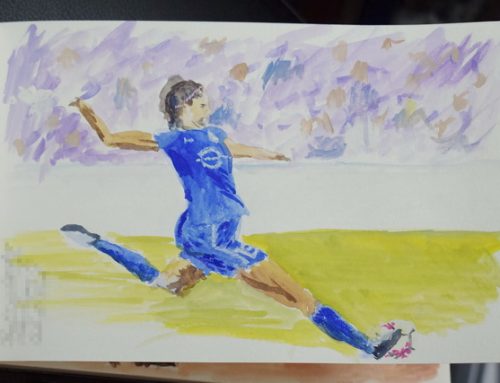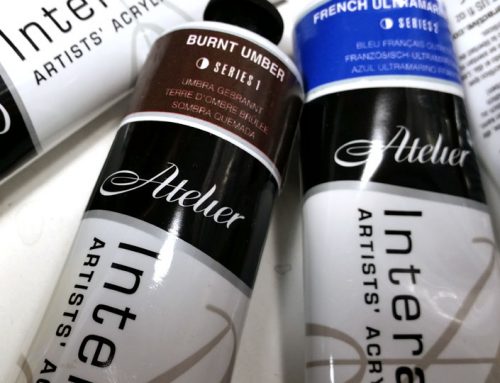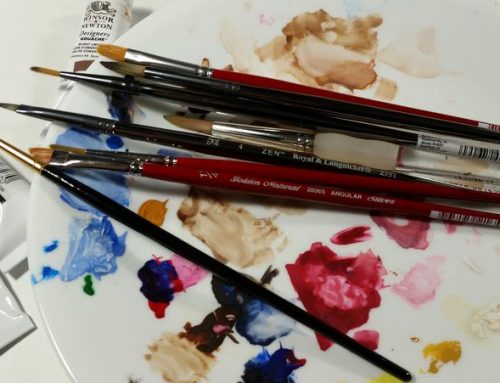One aspect of airbrushing that adds an element of difficulty peculiar to the discipline is the use of masks and shields. These spray obstructions are important tools in the shaping of crisp artwork. When you branch away from the store-bought products, the artist must then consider what material to use for their custom masks and shields (M/S).
By the very nature of how a typical airbrush deposits color, it’s difficult to have very crisp transitions. Yes, with a lot of practice, a good brush, a steady hand, and a medium that’s amenable, you can make very sharp lines and transitions freehand on a small scale. Typically, though, you don’t want to be doing it all the time. That’s where M/S come in.
 The goal of both masks and shields is to present a barrier to the paint that is being sprayed — the primary difference between the two being that masks are fixed into position while shields are hand-held. When starting out, airbrushers will often use shields from Artool. I have many, myself. There comes a point when you need something that is peculiar to your own needs, so you set about making them yourself.
The goal of both masks and shields is to present a barrier to the paint that is being sprayed — the primary difference between the two being that masks are fixed into position while shields are hand-held. When starting out, airbrushers will often use shields from Artool. I have many, myself. There comes a point when you need something that is peculiar to your own needs, so you set about making them yourself.
In most cases, the first attempts at M/S are made from ordinary copier paper. Nothing wrong with that provided you also understand the paper’s major shortcoming: it absorbs water and then wrinkles/puckers. Especially when shooting water-borne paints (as I do), that wrinkle/pucker thing becomes a significant headache.
My feeling is that copier paper is fine for “quick blocking” M/S. By this I mean using the paper to transfer a design in a stencil-like fashion using a very light coat of color. This is a technique often used in lieu of drawing on your support–often when the support is fabric.
Non-absorbent materials are also available, particularly polyester film (e.g. Mylar). Personally, I prefer acetate film, but it’s not as widely available. The great advantage of these films is that they stand up to a lot of paint shooting without absorbing any liquid. Plus, they are clear, which makes transferring art–especially art that’s in-progress–fairly easy. The shortcoming of these are their difficulty to cut M/S with detail.

A piece of vellum, about 230 mm long (9-inches) that was used as a shield in a number of ways. Other than the paint and a crease I folded into it, it’s still in great condition.
My favorite all-purpose material for M/S is 100% rag vellum. Vellum is a translucent paper that is often used in drafting and architectural drawing. For the airbrusher, it’s a sturdy tracing paper (but do NOT confuse it for tracing paper which is horrible to airbush with) that doesn’t easily absorb liquid when sprayed. It’s grain is typically non-directional, meaning that unlike, say, a newsprint, it tears equally well (i.e. with control) in all directions. Other than it having the intrinsic fragility of paper, making it potentially ill-suited for long-term use, as well as being iffy when it comes to cleaning, it’s just about a perfect material for custom M/S.
Vellum is not quite as “see-through” as a tracing paper, but if your image has enough contrast, that shouldn’t be an issue. If it is, you can always use more transparent material as an intermediate generation. For prep work, especially, you’d probably want to use a light box or light table.
Almost all of my airbrush experience with vellum has been with water-borne pigments, so I don’t know if my enthusiasm would continue when using solvent-based paints. So, if you shoot uro, please know that you will need to test first and don’t just use my recommend. (Though if you’ve used uros and vellum, I’d be interested in knowing if it works.)
While I also make more long-lasting shields, my go-to material for M/S is most often going to be vellum. It’s easy to work with, I can transfer images, it’s flexible, it maintains its structure even when covered with paint, and it’s not so fragile that I have to treat it particularly delicately. If you’ve been looking for a good M/S material, I highly recommend to get some vellum and try it out for yourself. I think you’ll agree that it’s too useful not to have in your airbrushing toolbox.





